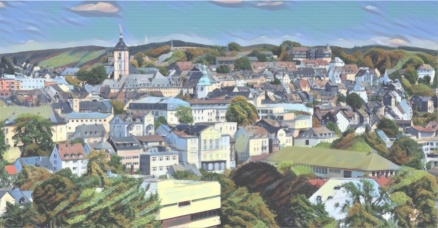Speaker
Description
The LHCb collaboration announced in 2021 the discovery of a new tetraquark-like state, named $T_{cc}^+$. The $T_{cc}^+$ is reminiscent of the $X(3872)$, which is a candidate for a loosely-bound $D\bar D^*$+h.c. molecule; however, we are now dealing with an open-charmed state which radically changes its nature and makes it explicitly exotic. In this talk, the recently discovered $T_{cc}^+$ is evaluated as a $DD^*$ molecular structure in the $J^P=1^+$ sector [1]. A coupled-channel calculation in the charged basis, considering the $D^0D^{*\,+}$, $D^+D^{*\,0}$ and $D^{*\,0}D^{*\,+}$ channels, is carried out in the framework of a constituent quark model that has successfully described other molecular candidates in the charmonium spectrum such as the $X(3872)$. The $T_{cc}^+$ is found to be a $D^0D^{*\,+}$ molecule ($87\%$) with a binding energy of $387$ keV/c$^2$ and a width of $81$ keV, in agreement with the experimental measurements. The quark content of the state forces the inclusion of exchange diagrams to handle indistinguishable quarks between the $D$ mesons, which are found to be essential for binding the molecule. The $D^0D^0\pi^+$ line shape, scattering lengths and effective ranges of the molecule are also analysed and found to be in agreement with the LHCb analysis. We search for further partners of the $T_{cc}^+$ in other charm and bottom sectors, finding different candidates. In particular, in the charm sector we find a shallow $J^P=1^+$ $D^+D^{*\,0}$ molecule ($83\%$), called $T_{cc}^\prime$, just $1.8$ MeV above the $T_{cc}^+$ state. In the bottom sector, we find an isoscalar and an isovector $J^P=1^+$ bottom partners, which are $BB^*$ molecules lying $21.9$ MeV/c$^2$ ($I=0$) and $10.5$ MeV/c$^2$ ($I=1$), respectively, below the $B^0B^{*\,+}$ threshold.
[1] P.G.Ortega, J.Segovia, D.R.Entem and F.Fernandez, "Nature of the doubly-charmed tetraquark Tcc+ in a constituent quark model", Phys. Lett. B 841 (2023), 137918 [arXiv:2211.06118 [hep-ph]].
| Consent | I consent to recording/broadcasting my presentation. |
|---|

